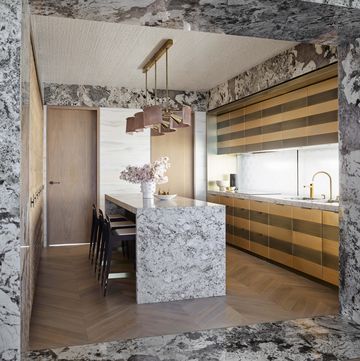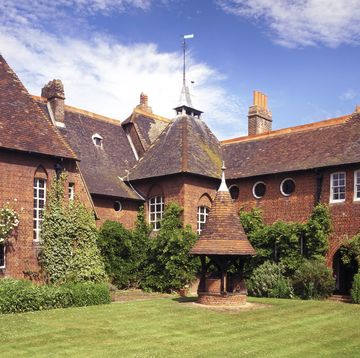By transforming buildings and streetscapes with bold graphics and vivid colours, four creatives have found a way to bring people together around messages of joy, hope and belonging. They are leading a wave of colour that is taking over once-unloved areas of our cities. We delve into what drives them to spread positivity through paint…
The healthcare hero, Morag Myerscough
Vibrant architectural structures are the speciality of this artist, whose latest project sees her turn a hospital courtyard into the aptly named Joy Garden
Morag Myerscough has brought her trademark graphic style to large-scale artworks in all kinds of locations, from a bandstand that toured around Sussex to a recreation of a historic gatehouse on Hadrian’s Wall in Northumberland. Yet the projects that are closest to her heart are those she has created in hospitals. ‘I just want to make people happy,’ she says. ‘Something in a hospital is purely about uplift; you can create a distraction from whatever trauma or pain someone is suffering by giving them a moment of joy or laughter.’
What's everyone reading?
While revamping bedrooms at Sheffield Children’s Hospital, an unloved courtyard caught the eye of the London-born artist. ‘It was clear it could be transformed into a beautiful, functional garden,’ she explains. The project became a labour of love. With little funding available, Myerscough convinced Method (a cleaning-product brand she had previously collaborated with) to cover most of the cost. The rest relied on resourcefulness: for instance, patterned flooring panels – originally created for a project that was unexpectedly cancelled – were brought here and repurposed.
Myerscough usually works with groups in the community to design and build her creations. While that wasn’t entirely possible here, the design does take cues from fragrance and colour workshops hosted with staff and the families of patients. The result is a Technicolor oasis filled with tropical plants, chromatic furniture and a marquee-style pavilion. ‘Some of the young patients are in the hospital for long stretches of time; they need to be able to go outside and feel the sun on their faces,’ says Myerscough. ‘We want them to feel like the circus has come to town.’ moragmyerscough.com
The makeover artist, Lakwena Maciver
From tube stations to road junctions, this rising star of the art world transforms mundane, forgotten areas of cities into places that instil community pride
For Lakwena Maciver, the transition from painting on canvases to taking over urban spaces was a natural one. ‘A lot of public spaces don’t have a sense of communal ownership; they’re just being used to sell you stuff,’ she says. ‘I’ve always been interested in trying to disrupt that.’ The UK-born artist first put this idea into practice with a flooring-tile mosaic that covered the 1,400-square-metre roof terrace of London’s Temple Station in stripe and chequerboard patterns. Like many of her artworks, the 2021 work integrated a powerful message. The statement ‘Nothing can separate us’ was a rallying cry to a city still feeling the impact of coronavirus lockdowns and social distancing.
Maciver’s latest project saw her collaborate with architecture studio IF_DO on an installation that is even more ambitious. On a Brent Cross site surrounded by motorways and railway lines, an electrical substation has been wrapped by a 21-metre-high kaleidoscopic structure that looks like a rollercoaster. Emblazoned with the words, ‘Here we come, here we rise and shine’, the artwork calls for celebration and optimism. ‘It’s this idea of building up, rather than tearing down,’ she explains.
Describing her work as being fuelled by themes of hope and redemption, Maciver has an artistic process that is intuitive, chaotic at times, and often influenced by emotions she feels while listening to music. ‘My work has different threads and layers,’ she says. ‘I hope people going about their daily lives can glimpse something that connects with them.’ lakwena.com
The LGBTQ+ champion, Adam Nathaniel Furman
Identity is key to the work of this queer designer, who draws from architecture and ceramics to create installations that proudly promote diversity
In the summer of 2021, a multi-coloured pyramid was erected in London’s Granary Square. Its surfaces were adorned with graphic motifs that appeared cute and playful but were, in fact, carefully compiled to reference how, across history, the area has been a place of free expression for the LGBTQ+ community. This duality epitomises the work of London-based Adam Nathaniel Furman, whose designs are underpinned by their own experiences of navigating the city as a queer person.
Furman trained in architecture before adopting a more multidisciplinary approach. Their work incorporates an unusual blend of architectural histories, particularly those that relate to marginalised communities, and a flamboyant, decorative style. ‘For a long time, people didn’t understand my work,’ they say. ‘It was seen as fun and playful but not taken seriously. Now people are finally understanding how ornament, decoration and colour can speak about identity, community and place.’
Ceramics often feature in Furman’s designs, either in the form of 3D-printed objects or as large-scale interventions covered in tiles. They have partnered with the London School of Mosaics on a 57-metre-long mosaic mural, A Thousand Streams, at London Bridge station. Referencing the station’s history as a melting pot of diverse communities, the mural is being built by amateur craft makers. ‘I like to get disadvantaged people involved,’ says Furman. ‘Public art shouldn’t be about superficial, temporary activations; it should feed a craft economy and create a lasting sense of place.’ adamnathanielfurman.com
The grief therapist, The Fandangoe Kid
Artist Annie Nicholson channels her own experiences with grief into pop-up artworks that help people find new ways of tackling mental-health issues
Few people understand grief better than graphic artist Annie Nicholson, who goes by the moniker The Fandangoe Kid. In 2011, she lost several members of her immediate family in a tragic helicopter accident in New York. The experience completely changed her approach to creativity, which became an important outlet for her to process her emotions. ‘There were no platforms for me to explore my grief, so my sketchbooks became an essential way of navigating it,’ she explains.
When the pandemic hit, Nicholson found herself thinking about these experiences of loss and isolation, and how she could use her artwork as a way of supporting others going through difficult times. Together with Carly Attridge, founder of grief-support charity The Loss Project, she took to the road in a customised ice-cream van (pictured top) that invited people to open up about their mental-health struggles while enjoying a mint-choc chip. ‘The idea was to facilitate spaces for dialogue, rather than come up with a prescriptive idea of what it is to grieve,’ she says.
The second iteration of the project saw Nicholson team up with architects Caukin Studio on a custom-built version called the Fandangoe Skip (pictured right), which combined Nicholson’s candy-coloured graphics with built-in seating spaces. Now, the artist offers people a different outlet for their grief. The Fandangoe Discoteca is a 1960s-inspired dance kiosk that will host ‘grief raves’. ‘We found people have moved on from being really desperate to talk to wanting to shake it out,’ she says. fandangoekid.com




















